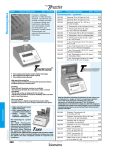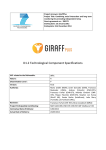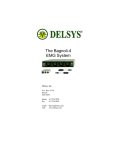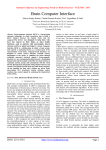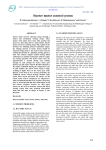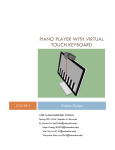Download Here - An International Journal For Engineering
Transcript
February. ISSN: 2321-8134 IJFEAT INTERNATIONAL JOURNAL FOR ENGINEERING APPLICATIONS AND TECHNOLOGY HEART ATTACK DETECTION SYSTEM USING ANDROID PHONE Mayur R. Bhoyar1, Suraj Chavhan2, Shubham Kalbande3, Nikhil Thengadi4 CSE Department, JDIET, Yavatmal,[email protected] CSE Department, GCOEA, Yavatmal, [email protected] CSE Department, JDIET, Yavatmal, [email protected] CSE Department, JDIET, Yavatmal,[email protected] Abstract This project is a step towards the preventative healthcare for patients who are suffering from heart problems. It seeks to develop a smart mobile ECG monitoring system that continuously monitors what is happening around the subject when an arrhythmia event occurs. The problem we are facing now is the unexpected death of our loved ones because of the sudden heart attack. Because of the changing life style the heart attack rate is increasing day by day. The current heart attack death rate is about 25% of the total deaths in India. The only reason behind heart attack death is the lack of medical care at instant..Here I am presenting an android based portable ECG monitor. The patient will be given a small device which senses the ECG data. This small device send the sensed data to the patient’s Android mobile through Bluetooth. The Android mobile will be having an application which will be running a heart attack detection algorithm. If in case any abnormalities are found the patient will be notified through an audible alarm and first aid techniques will be shown to the patient in the phone’s display. This first aid instruction will increase the chance of survival of the patient. An ECG report will be send to the patient’s doctor through email so that he can prepare himself for the treatment. And also a SMS will be send to the hospital that contain exact patient’s location(GPS) so that help can be given at the earliest even if the patient is travelling. The goal is to provide early heart attack detection so that the patient will be given medical attention within the first few important hours, therefore greatly improving patients chances of survival. Index Terms: Electrocardiograms (ECG), cardiac patients, Android, ADAS. --------------------------------------------------------------------- *** -----------------------------------------------------------------------1. INTRODUCTION may provide crucial information for a rapid diagnosis of medical conditions in astronauts; preventing the growth of any health condition to proportions susceptible to cause mission failure or even death of a crew member. The conventional telemetry system they employ limits the freedom of movement of the subjects whose bio potentials are being measured.Initially most of these systems receive power from an electrical outlet and are heavy enough to require wheeling to be displaced; making casual movements or urgent transportation of patients from one location to another very difficult , thus resulting in patients being mostly confined to their beds while in a hospital. And, although such stationary conditions might be acceptable in the case of a bed-ridden patient, it cannot be used for astronauts, athlets, politicians, etc. who are required to constantly move by their activities. The alternative commercially available ECG devices which can be used under severe non-stationary conditions such as athletic scientific studies are very limited and prove to be costly. These devices are also usually avoidable because of Electrocardiograms (ECG) have long been used in the hospital environment to diagnose cardiac arrhythmias and screen for heart disease. However, patients had to be tethered to the ECG machine by a few feet of wire. The mobile wireless ECG system is an electrocardiogram with wireless data transmission capabilities. With this invention patients can now move freely around their environment, allowing their caregivers to easily monitor the patient’s status at any location. ECG is used to measure regularity of heartbeats, size and position of the chambers, any damage to the heart, and the side effects of drugs or devices that is used to regulate the heart, such as a pacemaker. One of the invariable risks associated with space missions are the threats posed by the very harsh spatial environments to the physical and mental health of the astronauts. Exposing them to these types of environment for long months of time has adverse impact on cardiac, muscular, functions on astronauts The continuous monitoring of physiological parameters such as electrocardiography, oxygen saturation in hemoglobin and variability of cardiac frequency http://www.ijfeat.org(C)InternationalJournalFor Engineering Applications and Technology[79-82] February. their more weight, rigid structure and construction of lead cables running from patient to monitor. The goal of our project is to design and fabricate a Android based portable ECG monitor to help eliminate the restrictions caused by lead wires in conventional systems used in hospitals by permitting the acquisition and wireless transmission of a signal from sensor to recorder. In hospitals, my device allows a patient’s vital signs to be kept track of at all times despite his/her proximity to a bedside monitor. The device will be battery powered, double insulated and isolated. Audio and visual alarms will also be implemented into the device (Android mobile) in order to warn the user when a measured parameter reaches a critical level. Furthermore it will show the first aid details on the screen. 2. PROBLEM STATEMENT Using current electrocardiograms in hospitals can be a timeconsuming and unsanitary task. Connecting and disconnecting ECG leads from hospital room to hospital room takes up valuable time that nurses could be using to focus on the patient’s ailment. Changing wires also introduces bacteria to the patient, further increasing the risk of infection. During a heart attack, heart muscle is depraved of oxygen and will literally die if the artery remains blocked. The first few hours are critical in saving much of the dying heart muscle and preventing permanent heart damage. Unfortunately, the symptoms vary and the most common reason for critical delays in medical treatment is lack of early warning and patient unawareness. It is possible to detect the onset of a heart attack and eliminate patient error using this project. The current systems are very heavy and very costly. Thus a patient can’t carry it with him all the time while he is doing his work. The current systems which have automatic diagnosis will cost more than 75K. 3. MOTIVATION The number of deaths caused by heart attacks is about 25% of the total deaths in India. This occurs due to the delay in detecting the symptoms or lack of early diagnosis. This can avoided by integrating the mobile computing technologies with healthcare systems. Which will lead to the detection of abnormal heart rhythms and predict heart attack before it occurs. 4. PROJECT OBJECTIVE Project objective is to develop a Portable ECG monitor that will continuously monitor the ECG. It will notify the user and the doctor through email if any irregularities occur. If the signal is above the critical threshold then it will generate alarm and it will also send the GPS location to the hospital so that help can be provided at the earliest. This project will allow a patient to move freely and at the same time can be monitored continuously. 5. LITERATURE SURVEY ISSN: 2321-8134 Currently there are a few mobile electrocardiograms being implemented. But they do not have any automatic detection method to diagnose illness. Whenever heart discomfort occurs patient have to press a button which will lead to the generation of ECG and will be send to the physician who have to manually interpret the ECG. Other device in market is Zenicor-ECG, here the patient have to take reading at regular intervals and the doctor have to manually detect the variation in heart rhythm. The readings are user initiated and the data will be send to a database. The doctor has to manually check the database and then only the problem can be diagnosed. If the more number of patients are using Zenicor-ECG it will take a lot of time for the doctor to check the report and the checking interval will increase as the number of patients increases. The OMRON HCG-801 can record and store electrocardiogram (ECG) measurements of your heart rhythm. Each ECG reading records an approximately 30-second measurement and these ECG readings can help your doctor monitor your condition. The monitor is supplied with an SD memory card that can store up to 300 measurements, including the ECG data along with the date and time of measurement. The main disadvantage of this is it doesn’t have leads that attach to the body the device has to be kept in a particular angle in order to get correct measurement otherwise the data acquired will be not accurate and will lead to wrong diagnosis. And also it doesn’t have wireless capabilities so the patient has to physically carry the device to the doctor in order to diagnose the problem. The Ambulatory Data Acquisition System (ADAS) is composed of the recorder base and the signal input module. The recorder base gains signals from twelve sensors through the signal input module. This can measure ECG, limb position, heart rate, blood pressure, skin temperature, respiration and skin conductance level. After the sensors pick signals, they are processed, displayed, saved and transmitted to a HRF portable computer (PC), which allow the users to setup the recorder base and view the signals. The ADAS has a 32 bit processor. It has the ability to record signals with very small amplitudes (0-125 mV) and differentiated analog signals from -62.5mV to 62.5 mV (Delsys Inc., 2004). In order to have a continuous monitoring of the patient’s health, the patient has to wear the base recorder the whole time that weights approximately 1 Kg (Delsys Inc., 2004). Also, the base recorder will be connected to the electrodes via wires that may reduce the patient’s freedom of motion. The LifeSync Wireless ECG System is an innovative method for monitoring a patients ECG without the attachment of any data cable between the electrodes and the monitor. This device is composed of a patient transceiver, which acquires the bio potential via leads attached to 3 or 12 electrodes placed on the patient’s skin. Once, the signals are acquired, they are strengthen and transmitted using a Bluetooth module embedded in this first unit to next, the monitor transceiver. The monitor transceiver is connected via input cables to a conventional monitor which then processes the signal as usual: numerical display of heart rate, graphical display of waveform,etc . The two units together make up for a small very low weight system that allows its users more freedom of http://www.ijfeat.org(C)InternationalJournalFor Engineering Applications and Technology[79-82] February. movement without jeopardizing continuity of ECG monitoring. It also reduce the need for connecting and disconnecting lead wires when a patient needs to be transported. The absence of heavy obstructing cables also reduces the amount of noise that interferes with the signal displayed on the monitor as a waveform. The main disadvantage of this is its just act as a wireless sensor and nothing else. It can’t display the ECG nor it can analyse it. It still needs a general and heavy ECG monitor which weighs more than a kilo. HOSPITAL BEDSIDE MONITORS are generally used in hospitals to monitor the health status of patients.The specifications of these must be thoroughly considered since it constitutes one of the basis for the minimum required specifications for the system proposed here. ISSN: 2321-8134 Fig 1. Proposed system overview 7.2 Advantages Automatic detection of heart attack Alert the user by sending quick notes on mobile and tells him how to perform first aid Alert the ambulance service along with the location Alert the physician so he can prepare for the treatment Frequent visit to hospital reduces No need of additional computer for transmitting the report 7.3 Disadvantages 6. DRAWBACKS OF EXISTING SYSTEM Does not have any automatic detection method Somebody has to watch over the reports for abnormality Some of them take reading only at the time of heart attack by pressing a switch, which won’t be of much help. Report should be uploaded to a computer for transferring it to the physician The ECG monitor which has automatic detection algorithm is bulky and costly Unavailability of networks leads to failure in alerting ambulance and doctor As I am using Bluetooth power consumption will be more Proposed system overview is shown in Figure 1. A circuit will be worn by the user which will be connected to the android phone using Bluetooth connection. Android phone will process the signals. Detailed description of the sender and receiver is specified below 8. AT THE SENDER (ECG MONITOR) 7. SYSTEM DESIGN 7.1 Proposed Solution: The proposed prototype is a portable ECG monitor based on android. A patient will wear the mobile ECG monitor that gathers heart rhythm data and transmits it wirelessly to an android phone for storing and analysis. The android phone will be running detection algorithms to automatically detect abnormal variations in heart rhythm. Since the android is based on Linux it will be easy to port it to other Linux based platforms like PC or PDA etc. The detection of abnormal heart rhythm will be performed by the android phone which can be achieved by introducing a new detection algorithm using the possibilities of image processing. If any abnormal event occurs it will send an SMS to the ambulance which will be containing the patient’s location (GPS data) which will help the ambulance to reach faster. And a copy of the ECG will be send to the physician through GPRS so that he can make necessary arrangements. The overview of the proposed system is shown in Fig.1. Figure 2 shows the function of sender that is the circuit worn by the patient. Sensor leads will detect the weak electric signal generated by the beating of the heart. The weak electric signal will be amplified by amplifiers. Then the resulting amplified signal will be send to the receiver. Fig. 2 Sender (ECG monitor) Architecture 9. AT THE RECEIVER (ANDROID PHONE) The receiver receives the data send by the circuit and it will display the ECG in its screen. At the same time the application will calculate the values and it will compare it with the threshold. If the calculated value crosses the threshold value then three alarms are raised. First alarm is for the user which will inform the user that he is going into a cardiac arrest and it also includes instructions for first aid. Second alarm is http://www.ijfeat.org(C)InternationalJournalFor Engineering Applications and Technology[79-82] February. for the ambulance driver in the form of an SMS. This SMS includes the location of the user so that he can be taken to the hospital with less time. The third alarm is for the doctor in the Form of an E-MAIL which contains the ECG signal. The doctor can make the necessary arrangements before the patient is brought to the hospital hence saving the time and will increase the chance of patients survival. 10. CONCLUSION An effective heart attack detection system is proposed in this project. It helps to reduce deaths caused by heart attacks since the main cause of heart attack deaths are due to delay in proper treatment. This can be avoided since the system will notify the doctor with ECG report and his present location. Since the android is based on Linux it will be easy to port it to other Linux based platforms like PC or PDA etc. 11. FUTURE WORK This idea can be further modified to add biometric authentication using ECG. The problem of remembering password can be avoided. The circuit can be modified in such a way that it can be implanted on the body. The algorithm can be expanded to detect additional heart ailments REFERENCES [1] The 8051 microcontroller by Kenneth J.Ayala. [2] http://www.edgefxkits.in/wireless-electronic-noticeboard-using-gsm.html [3] Pawan Kumar, VikasBhrdwaj, Kiran Pal, Narayan Singh Rathor, Amit Mishra, “GSM based e-Notice Board” , International Journal of Soft Computing and Engineering (IJSCE) ISSN. [4] Life Sync Corp., “Why the LifeSync System ?,” [Sales Literature], [citied 2007 Sep 4] [5] “A mobile phone-based ECG monitoring system” http://www.ncbi.nlm.nih.gov/pubmed/16817611.pdf [6] “Delsys Inc. (2004). Myomonitor III User Manual. EKG Monitoring System” http://instruct1.cit.cornell.edu/courses/ee476/FinalProjects /s2001/jl175/EE476.htm http://www.ijfeat.org(C)InternationalJournalFor Engineering Applications and Technology[79-82] ISSN: 2321-8134





